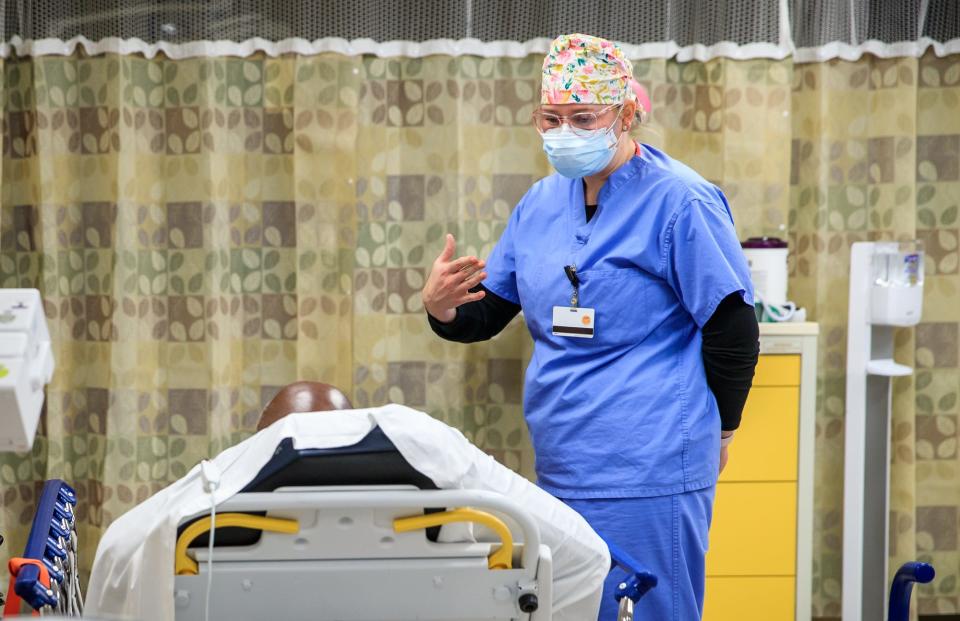Op/Ed: We have a shortage of health care workers in Indiana. Here's how to solve it.
Indiana is caught in a vicious cycle. We face a dire shortage of both health care workers (doctors, nurses, mental health specialists and the like) and public health specialists (e.g., public health nurses, environmental health specialists, epidemiologists). The lack of such experts has contributed to Indiana’s persistent public health issues. Indiana does not have adequate health services or the infrastructure to promote a healthy lifestyle, which is driving people out of the state — particularly from rural areas — at an alarming rate. And, as people who work in public health and rural development at Indiana University Bloomington, we know who is leaving: it’s exactly the health care providers and public health professionals we desperately need, and that we’ve spent the resources to train in Indiana.
So, the cycle repeats itself: the shortage of critical workers gets even worse, causing more people to leave. And, with each cycle, our economy and our people suffer.

The cycle is moving fast. Indiana experienced anemic population growth in 2022, adding just 19,000 people despite a population of 6.8 million. Even that troubling stat doesn’t tell the full story. Rural counties, where health care access is worst, are experiencing rapid population decline. Rural Indiana’s population declined by 2.2% from 2010-2020 — even as the nation’s population grew by 7.4% — and 75% of counties in Indiana had a population decrease in 2022.
More: Op/Ed: Indiana regularly ranks low in U.S. health statistics. Here's how we change that.
Indiana must end this cycle, so we must ensure that health care and public health workers are supported, have the training they need to be effective and can grow roots in our state. This will require significant monetary investment, widespread training and innovative thinking.
We are up to the task, but we have a long way to go. We are not a healthy state. We rank 35th in overall health, according to the America’s Health Rankings report, including 40th in life expectancy, 42nd in mental health, 46th in air quality, 41st in access to dental care and 40th in childhood immunization rate.
Not surprisingly, we rank 45th in public health funding.
Gov. Eric Holcomb has moved to fix our public health crisis. The Governor’s Public Health Commission report is honest; it admits that, even before the COVID-19 pandemic, our public health system was “struggling to meet our public health challenges.” It made a series of strong recommendations, particularly for training and retaining public health talent. It recommends standardizing job descriptions and providing salary ranges for those job descriptions that are competitive enough to keep talent here; creating incentives like student loan repayment programs for health care and public health workers who stay put; and collecting rigorous data to understand — and even predict — workforce needs.
There’s no such thing as a free lunch. Enacting those recommendations will require funding — the allocation in the recent legislative session is excellent progress — and it will be critical for the state legislature to appropriate adequate budgets well into the future. Yet if that money helps us keep Hoosiers healthy and in the state, it is money well spent. The Public Health Commission report makes this argument persuasively. As the old adage goes, “an ounce of prevention is worth a pound of cure.” Relatively modest investments in public health programs will save the much larger costs of taking care of sick people later.
More: Op/Ed: Indiana doesn't have enough primary care doctors — nurse practitioners can help
Still, money is not enough. It will also demand Indiana provide training for public health workers. Dr. Macy’s recent experience with a U.S. Health Resources and Services Administration (HRSA) grant is instructive. The $1.5 million grant provides for graduate-level training in public health for Indiana’s public health workforce, particularly in the state’s underserved areas. Given how overburdened these workers are, he wasn’t sure how many would apply.
He needn’t have worried. The demand was immediate, and the slots were filled in no time. The public health workforce is desperate to understand best practices, as many of them received their training in something other than public health and feel unprepared. In fact, a recent assessment of the state’s public health workforce reported that only 6.5% of local health department employees have formal public health training. They are happier and more likely to stay when they feel they are doing a good job.
Of course, the training also makes them better at keeping all of us healthy.
Continuing education for the public health workforce must be a priority if we are to keep them in Indiana.
More: Op/Ed: Don't solve doctor shortage by ending collaboration between medical professionals
Finally, we must ensure health care and public health workers-in-training — like the doctors, nurses, data analysts and epidemiologists we educate at IU — grow roots here and see where their careers could take them right here at home. It is incumbent upon universities and colleges to embed them in local healthcare facilities to learn while they work. Rural health facilities are particularly promising, as they empower students to do more advanced work that students won’t want to give up to move to a larger, urban hospital.
Indiana’s long-term prospects rely on us keeping the talent we train here at home, and that all starts with keeping health care and public health workers in the state. Keeping them here breaks the vicious cycle. We must do everything in our power to ensure they stay.
John Macy is interim assistant dean for Graduate Education and an associate professor at the Indiana University School of Public Health-Bloomington. Kerry Thomson is executive director of the Indiana University Center for Rural Engagement.
This article originally appeared on Indianapolis Star: Indiana's shortage of public health care workers creates vicious cycle

